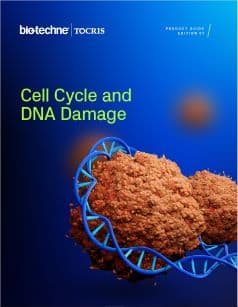Checkpoint Control Kinases
Checkpoint control kinases is a term used to describe a group of enzymes that regulate progression of a cell through the cell cycle. Catastrophic genetic damage can occur if cells progress to the next phase of the cell cycle before the previous phase is properly completed.
Checkpoint Control Kinase Inhibitors |
|
|---|---|
| Cat. No. | 产品名称/活性 |
| 7589 | Adavosertib |
| Potent and selective Wee1 inhibitor | |
| 5198 | AZ 20 |
| Potent and selective ATR kinase inhibitor; antitumor | |
| 3994 | AZ 3146 |
| Potent and selective Mps1 inhibitor | |
| 6330 | AZ 5704 |
| Potent and selective ATM kinase inhibitor; orally bioavailable. | |
| 5199 | AZD 7762 hydrochloride |
| Potent and selective ATP-competitive inhibitor of Chk1 and Chk2 | |
| 7549 | BAY 1816032 |
| Potent and selective BUB1 kinase inhibitor | |
| 4840 | KU 0060648 |
| Dual DNA-PK and PI 3-K inhibitor | |
| 3544 | KU 55933 |
| Potent and selective ATM kinase inhibitor | |
| 6454 | LY 2603618 |
| Potent and selective Chk1 inhibitor | |
| 3190 | Mirin |
| MRN-ATM pathway inhibitor | |
| 2828 | NU 7026 |
| Selective DNA-PK inhibitor | |
| 3712 | NU 7441 |
| Potent and selective DNA-PK inhibitor | |
| 3785 | PD 166285 dihydrochloride |
| Wee1 inhibitor; also inhibits Src, FGFR and PDGFRβ | |
| 2694 | PD 407824 |
| Potent and selective inhibitor of Chk1 and Wee1 | |
| 2930 | PI 103 hydrochloride |
| Inhibitor of DNA-PK, mTOR and PI 3-kinase | |
| 2560 | SB 218078 |
| Chk1 inhibitor | |
Degraders |
|
| Cat. No. | 产品名称/活性 |
| 7240 | ZNL 02-096 |
| Potent and selective Wee1 Degrader; arrests cells in the G2/M phase and induces apoptosis | |
Other |
|
| Cat. No. | 产品名称/活性 |
| 4763 | Pyridostatin pentahydrochloride |
| Stabilizes G-quadruplexes; induces DNA damage and cell cycle arrest | |
Checkpoint control kinases is a term used to describe a group of enzymes that regulate progression of a cell through the cell cycle. Catastrophic genetic damage can occur if cells progress to the next phase of the cell cycle before the previous phase is properly completed. Checkpoint control kinases function to halt the cell cycle at these critical points. Examples of checkpoint control kinases include ATM, ATR, DNA-PK, Chk1, Chk2, Wee1 and mTOR.
For a cell to progress through the cycle and replicate, it must pass through checkpoints between phases to ensure that DNA is replicated correctly and that chromosomes segregate. These checkpoints may stop the cell cycle after DNA damage, loss of DNA replication or disruption of the mitotic spindle, in order for repair processes to take place. If cells containing damaged DNA were to divide, the errors would be transmitted to daughter cells, generating genomic instability and resulting in tumorigenesis or apoptosis.
Literature for Checkpoint Control Kinases
Tocris offers the following scientific literature for Checkpoint Control Kinases to showcase our products. We invite you to request* your copy today!
*Please note that Tocris will only send literature to established scientific business / institute addresses.
Cell Cycle and DNA Damage Research Product Guide
This product guide provides a review of the cell cycle and DNA damage research area and lists over 150 products, including research tools for:
- Cell Cycle and Mitosis
- DNA Damage Repair
- Targeted Protein Degradation
- Ubiquitin Proteasome Pathway
- Chemotherapy Targets
Cell Cycle & DNA Damage Repair Poster
In normal cells, each stage of the cell cycle is tightly regulated, however in cancer cells many genes and proteins that are involved in the regulation of the cell cycle are mutated or over expressed. This poster summarizes the stages of the cell cycle and DNA repair. It also highlights strategies for enhancing replicative stress in cancer cells to force mitotic catastrophe and cell death.
Checkpoint Control Kinase Gene Data
| Gene | Species | Gene Symbol | Gene Accession No. | Protein Accession No. |
|---|---|---|---|---|
| ATM | Human | ATM | NM_000051 | Q13315 |
| Mouse | Atm | NM_007499 | Q62388 | |
| Rat | Atm | NM_001106821 | NP_001100291 | |
| ATR | Human | ATR | NM_001184 | Q13535 |
| Mouse | Atr | NM_019864 | Q9JKK8 | |
| Rat | Atr | XM_236563 | - | |
| DNA-PK | Human | PRKDC | NM_001081640 | Q9UME3 |
| Mouse | Prkdc | NM_011159 | P97313 | |
| Chk1 | Human | CHEK1 | NM_001274 | O14757 |
| Mouse | Chek1 | NM_007691 | O35280 | |
| Rat | Chek1 | NM_080400 | Q91ZN7 | |
| Chk2 | Human | CHEK2 | NM_001005735 | O96017 |
| Mouse | Chek2 | NM_016681 | Q9Z265 | |
| Rat | Chek2 | NM_053677 | Q9R019 | |
| Wee1 | Human | WEE1 | NM_003390 | P30291 |
| Mouse | Wee1 | NM_009516 | P47810 | |
| Rat | Wee1 | NM_001012742 | Q63802 | |
| mTOR | Human | FRAP1 | NM_004958 | P42345 |
| Mouse | Frap1 | NM_020009 | Q9JLN9 | |
| Rat | Frap1 | NM_019906 | P42346 |

